中国汉字的介绍英文ppt
《我爱你,中国的汉字》PPT
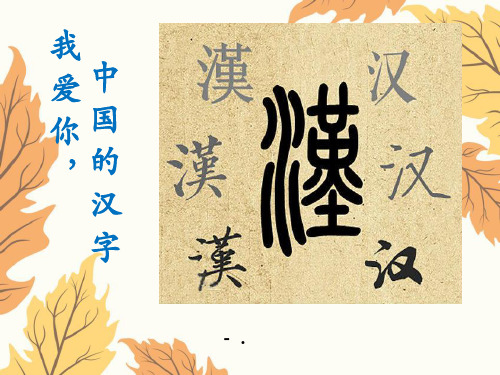
简单叙述每部分的内容:
段落大意
第一部分( 1)总起全文,表达对汉字的喜爱之情。
第二部分(2-5)从四个方面赞美汉字的独特魅力。
第三部分(6)总结全文,表达对汉字的珍爱与赞美。
我爱你,中国的汉字
形象美,像……像……意境美,是一群小精灵字体美,有自己的风韵韵律美,带来诗的灵性
喜爱珍惜赞美
结构图示
1.第①段最后一句用“真不忍”“真想”表达了作者怎样的思想感情?
“真不忍”“真想”表达了作者对汉字的珍爱之情。这两个词语让读者深刻地感觉到作者对汉字就像对自己心爱的孩子、亲人和朋友一样。
再读课文
读课文,思考问题。
2.第②段可以分为几层?各写了哪些内容?用了哪些修辞手法?
你有什么感悟?
品读感悟 汉字不光美妙有趣,还有着悠久的历史,蕴含着丰富的文化。它记载着我们中华民族文化的发展历史,它是蕴涵着中华民族独特审美情趣的精灵,而不是僵硬的无生命的符号。让我们更深入地去了解汉字吧,去领略它的无限魅力,从汉字中去体悟中华民族绵延几千年的情感和智慧。
选择一种或多种修辞手法写一段话
整体感知
特点
魅力
喜爱
珍惜
赞美
文章语言优美,修辞手法丰富,找一找优美或者使用了修辞手法的句子。
特殊语句
1.它们像一群活泼可爱的孩子在纸上玩耍嬉戏,像一朵朵美丽多姿的鲜花愉悦你的眼睛。——拟人
2.这是一些多么可爱的小精灵啊!——比喻
3.看着这些有色彩、有声音、有气味的词,怎能不诱发你调动这些语言的情绪呀!——排比
组词:
勒(勒令)(勒派)(勒索)勒(lēi)掯
辨字:
勤(勤劳)(勤奋)(辛勤)
造句:
中国书法汉字讲解 英文
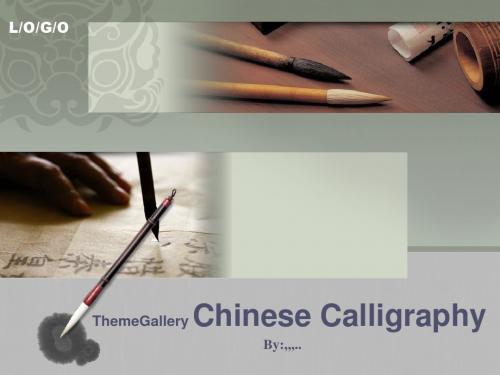
Percentage of characters
Can you guess?
• Which kind of group do they belong to respectively? • 日 上 齿 鸣 空 万
Can you guess?
日 上 齿 鸣 空 万
象形 指事 形声 会意 转注 假借
The evolution of Chinese characters font
• Jiǎgǔwén (Oracle Bone Script )→Jīnwén (Bronzeware script) →Dàzhuàn (Large Seal Script) →Xiǎozhuàn →The Lìshū style (clerical script) →Kǎishū style (traditional regular script)
interpretation
• Listen to the following audio and then translate it with your own words.
L/O/G/O
Thank You!
L/O/G/O
ThemeGallery
Chinese Calligraphy
By:,,,..
Contents
Arrangement about this part
introduction
characters
classification Materials and tools interpretation
Describe the strokes
Classification
• Through the centuries Chinese characters have changed constantly and are mainly divided into five categories today: • the seal script sic strokes of chinese characters
《我爱你,中国的汉字》PPT-完美版
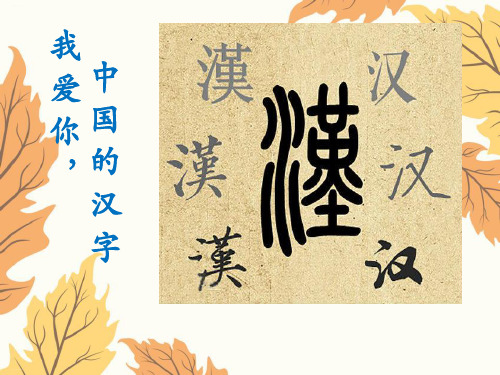
字义: ①强制,逼迫;②〈书〉带嚼子的 马笼头;③〈书〉统率;④〈书〉 雕刻。
组词: 勒(勒令)(勒派)(勒索) 勒(lēi)掯
辨字: 勤(勤劳)(勤奋)(辛勤) 造句: 这家污染环境的化工厂被勒令停业。
《我爱你,中国的汉字》PPT-完美版
《我爱你,中国的汉字》PPT-完美版
骋
chěnɡ 马
十画 左右 动词
读课文,试着填一填。
《我爱你,中国的汉字》通过展示汉字的各 种( 特点 ),表现了汉字的独特( 魅力 ),表 达了作者对汉字的( 喜爱 )、( 珍惜 )与 ( 赞美 )之情。
《我爱你,中国的汉字》PPT-完美版
《我爱你,中国的汉字》PPT-完美版
特殊语句
文章语言优美,修辞手法丰富,找一找优美或者使用了修 辞手法的句子。
《我爱你,中国的汉字》PPT-完美版
《我爱你,中国的汉字》PPT-完美版
读写易错提示
正音: 门框(kuànɡ√kuānɡ)沉坠(zhuì√zuì) 脂肪(zhī√zī)
辨形: “骋”的右下部分不要写成“亏”; “魅”的里面是“未”,不要写成“末”。
《我爱你,中国的汉字》PPT-完美版
《我爱你,中国的汉字》PPT-完美版
字义: ①(马)奔跑;②放开。 组词: 骋(驰骋)(骋怀)(骋目) 辨字: 聘(招聘)(聘用)(解聘)(应聘) 造句: 马儿在一望无际的草原上驰骋。
魅
mèi 鬼
十四画 半包围 名/动
字义:①传说中的鬼怪;②诱惑,吸 引。
组词:魅(魅力)(魅惑)(魅人)
辨字:魁(魁梧)(魁首)(魁伟)(夺魁)
造句:西藏以它特有的魅力吸引着我。
我
爱
形象美,像……像……
你
介绍汉字 英语作文
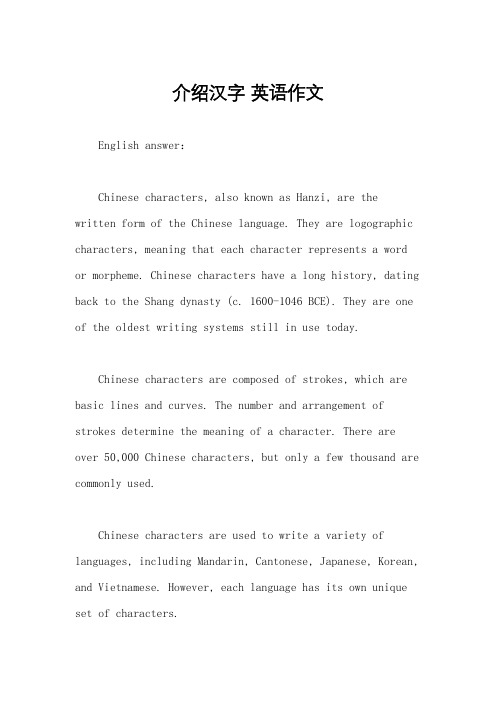
介绍汉字英语作文English answer:Chinese characters, also known as Hanzi, are thewritten form of the Chinese language. They are logographic characters, meaning that each character represents a word or morpheme. Chinese characters have a long history, dating back to the Shang dynasty (c. 1600-1046 BCE). They are one of the oldest writing systems still in use today.Chinese characters are composed of strokes, which are basic lines and curves. The number and arrangement of strokes determine the meaning of a character. There are over 50,000 Chinese characters, but only a few thousand are commonly used.Chinese characters are used to write a variety of languages, including Mandarin, Cantonese, Japanese, Korean, and Vietnamese. However, each language has its own unique set of characters.Chinese characters are a complex and beautiful writing system. They are a valuable part of Chinese culture and history.中文回答:汉字,又称漢字,是中国语言的书写形式。
汉字与中国文化 探寻汉字之美 传承中华文化 汉子文化知识教育培训PPT模板

3.许慎:第一部字典里已 收录9353个汉字!
4.《康熙字典》收字 已达47035个
汉字的文化信息
字族中的文化信息
《说文解字》收录了104个“马”字部的字。駒、馼、騏、駁、騅、骄 、笃、駫、驳、骄、笃、骇、驚等。《说文解字》收录102个“禾”旁 的字,说明我国远古时期就有发达的种植业,生物学史也证明了我 国是稻米的故乡。如秀、私、秋、税、稳;香、兼等。“来”是麦子 的象形字,麦子是从西域引进来的作物
• 尽管如此,人们始终在探索着。一是期望发现“半 人”或类人猿,从“活着的化石”证实人类的进化过程 。另一种途径,从语言的亲属关系,或某些原始性 戳记,通过比较来推断言语的起源。
汉字的起源
•实 物 说 •结 绳 说 •契 刻 说 •八 卦 说 •图 画 说 •标 记 说
刻文 说字 、起 八源
二 、 文
图画记事是很重大的发明。连云港市郊西南九公里锦屏山马耳 峰南麓的将军崖发现的岩画,就是图画记事,已经接近于原始 文字,距今约 7000 年。近年发现的纳西族《白蝙蝠经》就是 典型的图画文字了,它完整叙述了纳西族人民流传的创世神话。
汉字的起源
三、汉字的构造 汉字的“六书”
• (1)象形 • (2)指事 • (3)会意
探/寻/汉/字/之/美/传/Biblioteka /中/华/文/化汉字与中国文化
【汉字文化知识教育培训PPT模板】
汇报人:XXX
汇报时间:20XX
肆叁贰壹
汉汉汉汉 字字字字 文的的的 化文基起 的化本源 传信知 播息识
目 录
汉字的起源 探/寻/汉/字/之/美/传/承/中/华/文/化
汉字的起源
一、言语的起源
• 在19世纪这一直被视为徒劳无益、想入非非的问题 。20世纪初巴黎语言学会上正式指定了一项永久性 的条文:规定会议论文不许论及言语起源问题。
书法文化第一节课(英文版)

The classification of Chinese Calligraphy 中国书法的分类 The hard pen calligraphy: 硬笔书法 Writing tools 1. Pen 2. Pencil 3. Fountain pen 4. Crayon
The soft pen calligraphy 软笔书法 Writing tools 1. Writing brush 2. Ink 3. Xuan paper
• 汉字,亦称中文字、中国字, 是汉字文化圈广泛使用的一 种文字,属于表意文字的词 素音节文字,为上古时代的 华夏族人所发明创制并作改 进,目前确切历史可追溯至 约公元前1300年商朝的甲骨 文。再由秦朝的小篆,发展 至汉朝被取名为“汉字”, 至唐代楷化为今日所用的手 写字体标准——楷书。汉字 是迄今为止连续使用时间最 长的主要文字,也是上古时 期各大文字体系中唯一传承 至今的文字。中国历代皆以 汉字为主要官方文字。
Course standard
1、掌握汉字起源、演变的过程。
Master the origin, evolution of the Chinese characters
2、了解中国书法的基本特征和发展脉络。
Understand the basic characteristics of Chinese calligraphy and development grain
The meaning of Cgraphy, is in the world a few words of all art forms, including Chinese Characters Calligraphy, calligraphy, Arabic calligraphy and mongolian. The" Chinese calligraphy“ is a unique traditional arts of Chinese characters. Tell from broad sense, calligraphy is a symbol of the written rules of language. In other words, calligraphy is in accordance with the characteristics and meaning of the text, with its calligraphic strokes, structure and composition writing, to become the aesthetic works of art. Chinese characters and calligraphy Chinese original art, known as: a poem without words, without the line of dance; no figure painting, silent music.
中国传统艺术中英文介绍sophia ppt课件
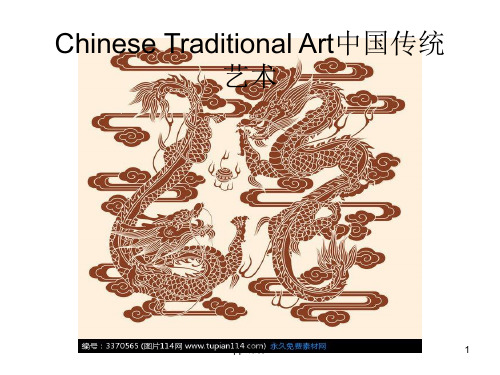
calligrapher, crafters, poet, architect, etc.
through their understandings of the
Chinese people, society and environment ,
which is presented to us, reflecting China's
→草书grass script
calligraphy
→行书running hand ( in Chinese
ppt课件
19
甲骨文 Oracle Bone Script
ppt课件
20
篆书 Seal script
ppt课件
21
金文 Inscriptions on bronze
ppt课件
22
隶书和楷书 Calligraphy and script
ppt课件
14
Kongming light
ppt课件
15
Chinese Calligraphy 书法 ---The spirit of Chinese culture
• -Calligraphy is understood in China as the art of writing a good hand with the brush or the study of the rules and techniques of this art. As such it is peculiar to China and the few countries influenced by ancient Chinese culture.
made by cutting paper with sci ssors to form different pattern s and pasting them on walls, wi ndows, doors and ceilings.
中国汉字的起源演变及分类PPT课件

二、汉字的演变
二、汉字的演变
毛泽东草书《忆秦娥 娄山关》 西风烈,长空雁叫霜晨月。霜晨月,马蹄声碎,喇叭声咽。雄关漫道真如铁,而今迈步从 头越。从头越,苍山如海,残阳如血。
(六)楷书
二、汉字的演变
二、汉字的演变
(六)楷书
楷书又称正书,或称真书。其特点是:形体方正,笔画平直,可作楷模,故名。始于东汉。 楷书的名家很多,如“欧体”(欧阳询)、“虞体”(虞世南)、“颜体”(颜真卿)、“柳 体”(柳公权)、“赵体”(赵孟頫)等。
秦朝的这一统一全国文字的重要措 施,对汉字的规范化起了很大的作用。
铸有小篆文字的秦虎符
印度前总理尼赫鲁对女儿说:
“世界上有一个伟大的国家,她 的每个字都是一首优美的诗,一幅美 丽的画,你要好好学习。”
汉字珍藏着中华民族五千年的全部精神财富。让我们真 正地热爱汉字,让每个汉字真正溶入我们的血液和情感里。 在今后的学习当中我们同学们要多阅读、多积累、多推敲, 正确地、自如地运用语言文字表情达意。
仓颉 (cāng jié)
黄帝 蚩尤(Chī yóu)
-、汉字的起源
-、汉字的起源
二、汉字的演变
甲金小隶 骨 文文篆书
草书 楷书
电
行
宋
脑
书
体
字 体
二、汉字的演变
(一)甲骨文
在约公元前14世纪的殷商后期,这时形成了初步 的定型文字,即甲骨文。甲骨文就是用写或刻的方式 留在龟甲或兽骨上的文字,它的象形程度比较高,因 为是刻在兽骨上,所以笔画比较细,直笔比较多。
毛公鼎及铭文
(二)金文
二、汉字的演变
在中国历史上的战国时期(公元前475-前221年),大 小诸侯国见于经传者有一百七十多国,但其中会盟、征伐事 迹之彰彰可考者,不外齐、鲁、楚、秦、晋、宋、卫、燕、 陈、曹、蔡、郑、吴、越等十数国。在春秋战国中期,先后 参与争雄的著名诸侯国有七个,即齐、楚、秦、赵、燕、韩、 魏,史称「战国七雄」。各国的文字差异很大,就像古老的 密码,很难破译。
汉字的英文介绍 Chinese Character(课堂PPT)
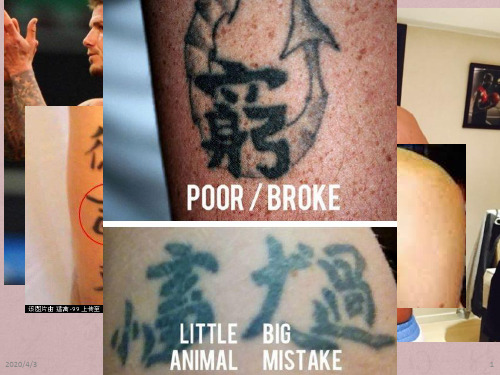
点击添up加标题
点击添加标题
down
木(mù) + 一=本(běn)
tree
root
2020/4/3
LO: To learn to talk about jobs/workplaces and where people do things
last
8g
3. Another method of creating new characters is to integrate two or more existi点ng击c添h加a标ra题cters to create a new character with a new meaning.
2020/4/3
1
2020/4/3
2
Do you know how long is Chinese in literature written?
China is the only country in the world with a literature written in one language for more than 3,000 consecutive years.
2020/4/3
刀(d点ā击o添) 加+标丶题=刃(rèn)
knife
点击添加标题
blade
木(mù) + 一=本(běn)
tree
root
LO: To learn to talk about jobs/workplaces and where people do things
7
one
点击添加t标w题o
5
xiàngxíng
Pictograms
1. Pictograms characters derive from pictures, they have been standardize点d,击s添im加p标li题fied, and stylized to make them easier to write, and their derivation is there点fo击re添n加o标t 题always obvious. Examples include for sun for 点击添加标m题oon, and ľ for tree.
介绍汉语英语作文
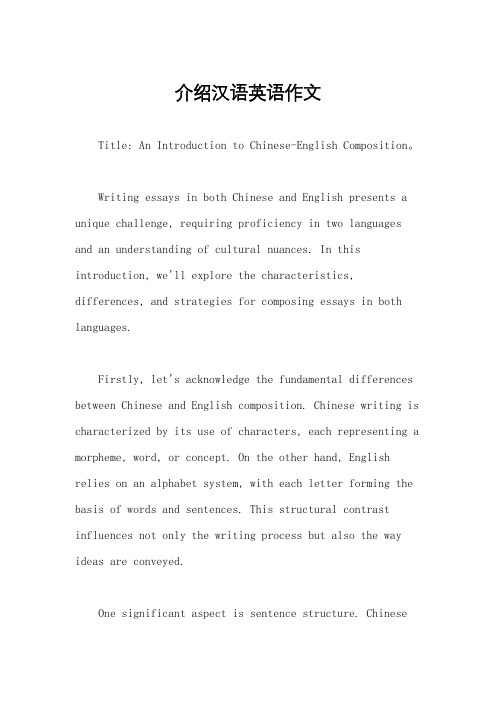
介绍汉语英语作文Title: An Introduction to Chinese-English Composition。
Writing essays in both Chinese and English presents a unique challenge, requiring proficiency in two languages and an understanding of cultural nuances. In this introduction, we'll explore the characteristics, differences, and strategies for composing essays in both languages.Firstly, let's acknowledge the fundamental differences between Chinese and English composition. Chinese writing is characterized by its use of characters, each representing a morpheme, word, or concept. On the other hand, English relies on an alphabet system, with each letter forming the basis of words and sentences. This structural contrast influences not only the writing process but also the way ideas are conveyed.One significant aspect is sentence structure. Chinesesentences often follow a subject-verb-object (SVO) order, while English typically adheres to a subject-verb-object (SVO) structure. Understanding these differences is crucial for effectively conveying ideas and maintaining coherence in writing.Another key difference lies in the use of idioms, expressions, and cultural references. Chinese essays may incorporate classical idioms and allusions, adding depth and richness to the text. In contrast, English essays may rely on idiomatic expressions and cultural references rooted in Western literature or popular culture. Balancing cultural elements while ensuring clarity and accessibility to the target audience is essential in bilingual composition.Additionally, tone and style vary between the two languages. Chinese writing often emphasizes harmony, modesty, and implicitness, reflecting traditional cultural values. English writing, meanwhile, may prioritize clarity, precision, and directness. Adapting tone and style to suit the language and context is vital for effectivecommunication.Now, let's discuss strategies for composing Chinese-English essays. Firstly, it's essential to have a strong command of vocabulary and grammar in both languages. This enables seamless expression and facilitates effective translation between Chinese and English.Secondly, understanding the cultural context of both languages is crucial. Familiarity with cultural norms, customs, and literary traditions enhances the authenticity and depth of the writing.Moreover, practicing bilingual writing regularly can improve proficiency and fluency. Engaging in activities such as translation exercises, language exchange, and reading bilingual texts can sharpen language skills and expand vocabulary.Furthermore, seeking feedback from native speakers and language professionals can provide valuable insights and help identify areas for improvement.In conclusion, writing essays in both Chinese and English requires linguistic proficiency, cultural awareness, and effective communication skills. By understanding the characteristics, differences, and strategies for bilingual composition, writers can enhance their ability to convey ideas accurately and compellingly in both languages.。
英语作文介绍汉字
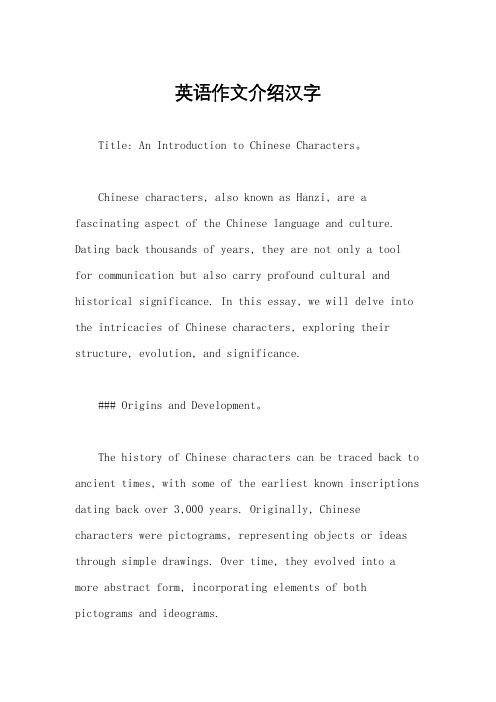
英语作文介绍汉字Title: An Introduction to Chinese Characters。
Chinese characters, also known as Hanzi, are a fascinating aspect of the Chinese language and culture. Dating back thousands of years, they are not only a toolfor communication but also carry profound cultural and historical significance. In this essay, we will delve into the intricacies of Chinese characters, exploring their structure, evolution, and significance.### Origins and Development。
The history of Chinese characters can be traced back to ancient times, with some of the earliest known inscriptions dating back over 3,000 years. Originally, Chinese characters were pictograms, representing objects or ideas through simple drawings. Over time, they evolved into a more abstract form, incorporating elements of both pictograms and ideograms.### Structure and Composition。
China文化PPT
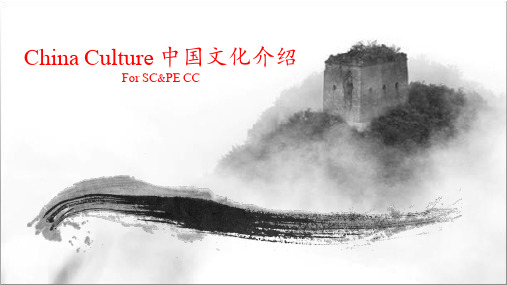
Chinese Chess Culture 中国棋文化
Chinese chess 中国象棋
I-go 围棋
Chess play ( I-go ) 围棋对弈
Chinese Wine Culture 中国酒文化
Traditional Wine Brewing 传统葡萄酒酿造
The great poet Li Bai 伟大诗人李白
中国国画
中国传统戏剧
Chinese Traditional Enlightenment Education 中国传统蒙学
Chinese Characteristic dress Chinese Folk Art 中国传统服饰 中国民间艺术
Traditional Chinese Medicine 中国中医文化
Chinese Zodiac 中国十二生肖
The Development of Chinese Characters 中国汉字发展史
China 中国瓷器
Chinese tradition festival Traditional Chinese literature
中国传统节日
中国传统文学
Chinese Painting Chinese Opera
Cuisine 烹饪
8 Series cuisine base on regions • Sichuan (川菜) • Shandong(鲁菜) • Jiangsu(苏菜) • Hunan(湘菜) • Guangdong(粤菜) • Fujian(闽菜) • Zhejiang(浙菜) • Anhui(徽菜)
全国有158个机场 2015年4.3亿人次。
I. General 概况 II. Life Elements 生活元素 III. Cultural Elements 文化元素 IV. Chinese Philosophy 中国哲学
《我爱你-中国的汉字》PPT课件
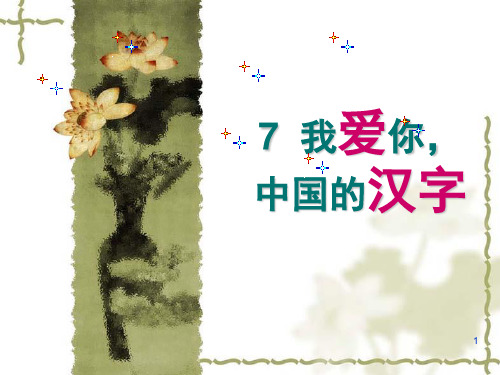
课文是怎么写的呢?请 用自己喜欢的方式朗读课文, 注意读准字音,遇到难读的字、 词、句子多读几遍。
10
我会读生字
11
我会组词。
框 相框 边框 韵 韵味 韵律 坠 坠下 坠落 幽 幽静 幽暗 勒 悬崖勒马 脂 胭脂 油脂 慧 彗星 智慧 骋 驰骋 骋目 魅 鬼魅 魅力 赖 赖账 依赖
骋目的意思是:放眼往远处看。 12
49让我们不神奇的让我们不神奇的汉字汉字去尽情去尽情地对话地对话用用心去体会心去体会汉字汉字的无限的无限魅力让我们都去爱魅力让我们都去爱汉字汉字54我写作的时候常常为我面前的我写作的时候常常为我面前的这一个个这一个个方块字方块字而动情
7 我爱你, 中国的汉字
1
请你读课题,课题写了什么?
对,作者爱汉字。
35
这些有影无形的图画,这些横竖勾 勒的奇妙组合,在记忆中留下无穷的 回味。于是作者在心底发出了由衷的 赞叹:我爱你 ,中国的汉字!
36
汉字又是世界上最漂亮的文字。没有人 不知道汉字书法有其他文字书法不能比拟的 魅力。行如流水的草书,秀丽的楷书,端庄 的大篆小篆,挺拔如峰,清亮如溪,浩瀚如 海……
37
行如流水的草书
38
秀丽的楷书
39
端庄的大篆小篆
40
或凝滑如脂
41
或挺拔如峰
42
或浩瀚如海
43
或清亮如溪
44
于是作者自豪地说:“在人类 古老的长河中,有哪一个民族像中 华民族有这么丰富的书法瑰宝?”
一个反问句,强烈地表达出作为中华 民族子孙的骄傲、自豪之情。
45
看着这些有色彩、有声音、有 气味的字词,怎能不诱发你调动 这些语言文字的情绪啊!
46
像徜徉在夏天夜晚的星空下,为那 壮丽的景色而迷醉,我无限钟情于我 赖以思维和交往的汉字,并震惊于它 的无限活力和奇特魅力。
介绍汉字的英语作文
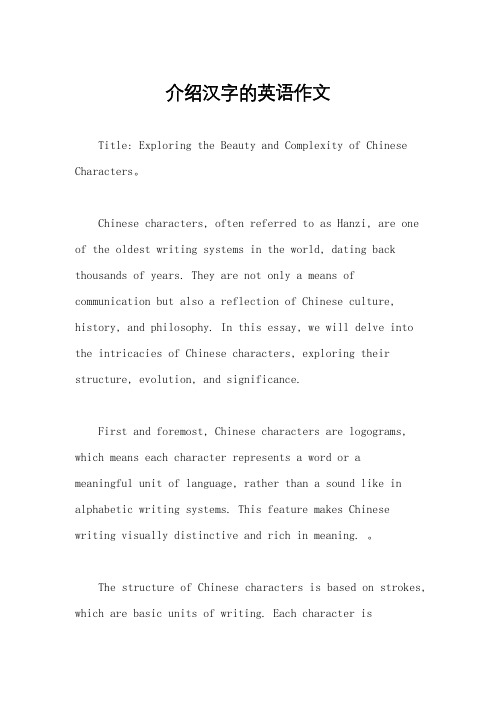
介绍汉字的英语作文Title: Exploring the Beauty and Complexity of Chinese Characters。
Chinese characters, often referred to as Hanzi, are one of the oldest writing systems in the world, dating back thousands of years. They are not only a means of communication but also a reflection of Chinese culture, history, and philosophy. In this essay, we will delve into the intricacies of Chinese characters, exploring their structure, evolution, and significance.First and foremost, Chinese characters are logograms, which means each character represents a word or ameaningful unit of language, rather than a sound like in alphabetic writing systems. This feature makes Chinese writing visually distinctive and rich in meaning. 。
The structure of Chinese characters is based on strokes, which are basic units of writing. Each character iscomposed of one or more strokes arranged in a specific order. Understanding stroke order is crucial for writing Chinese characters correctly and efficiently. There areeight basic strokes in Chinese calligraphy, including horizontal (一), vertical (丨), dot (丶), hook (亅), horizontal hook (乛), vertical hook (乚), left-falling (丿), and right-falling (乀). By combining these strokes in various ways, thousands of characters can be created.Moreover, Chinese characters have undergone significant evolution throughout history. The earliest known Chinese characters date back to the Shang dynasty (1600–1046 BCE) and were inscribed on oracle bones and bronze vessels for divination purposes. Over time, the script evolved into different styles, such as seal script, clerical script, regular script, cursive script, and running script. Each style has its own unique characteristics and aesthetic appeal, reflecting the cultural and artistic preferences of different periods.Furthermore, Chinese characters are deeply intertwined with Chinese culture and philosophy. Many characters arepictographic, meaning they are based on images of real objects. For example, the character for "mountain" (山) resembles three peaks, while the character for "sun" (日) resembles a circle with a dot in the center. Other characters are ideographic, representing abstract concepts or ideas. For instance, the character for "peace" (平) consists of the radical for "roof" (宀) over the radicalfor "one" (一), suggesting the concept of "tranquility under one roof." 。
向外国人介绍汉字英语作文
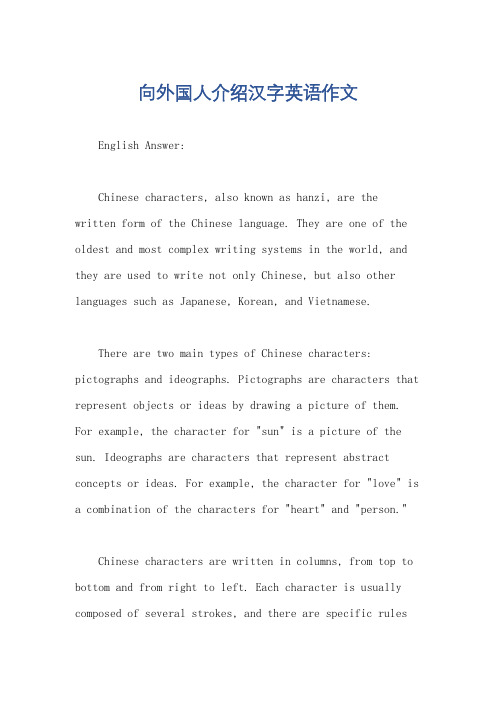
向外国人介绍汉字英语作文English Answer:Chinese characters, also known as hanzi, are thewritten form of the Chinese language. They are one of the oldest and most complex writing systems in the world, and they are used to write not only Chinese, but also other languages such as Japanese, Korean, and Vietnamese.There are two main types of Chinese characters: pictographs and ideographs. Pictographs are characters that represent objects or ideas by drawing a picture of them. For example, the character for "sun" is a picture of the sun. Ideographs are characters that represent abstract concepts or ideas. For example, the character for "love" is a combination of the characters for "heart" and "person."Chinese characters are written in columns, from top to bottom and from right to left. Each character is usually composed of several strokes, and there are specific rulesfor how these strokes are written. The order of the strokes is important, as writing a character in the wrong order can change its meaning.There are over 50,000 Chinese characters, but most people only need to know a few thousand to be able to read and write Chinese. The most common characters are used in everyday language, while the less common characters areused in more specialized contexts, such as in literature, science, and law.Learning to write Chinese characters can be challenging, but it is also a rewarding experience. Once you have mastered the basics, you will be able to read and write one of the most beautiful and expressive languages in the world.中文回答:汉字是中国语言的书面形式。
介绍汉语英语作文
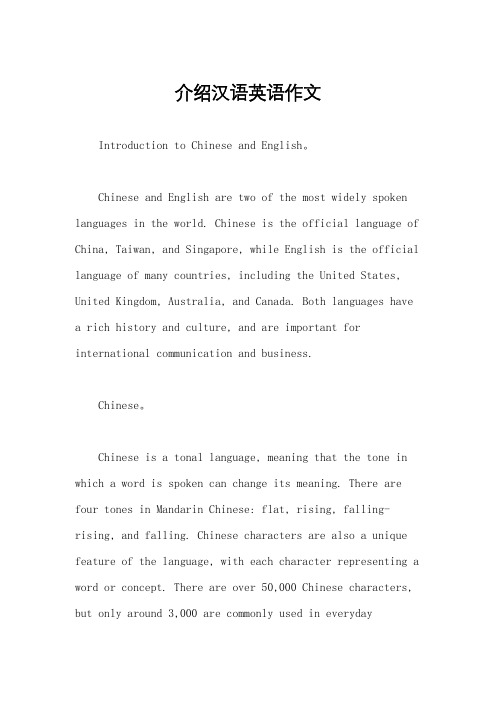
介绍汉语英语作文Introduction to Chinese and English。
Chinese and English are two of the most widely spoken languages in the world. Chinese is the official language of China, Taiwan, and Singapore, while English is the official language of many countries, including the United States, United Kingdom, Australia, and Canada. Both languages have a rich history and culture, and are important for international communication and business.Chinese。
Chinese is a tonal language, meaning that the tone in which a word is spoken can change its meaning. There are four tones in Mandarin Chinese: flat, rising, falling-rising, and falling. Chinese characters are also a unique feature of the language, with each character representing a word or concept. There are over 50,000 Chinese characters, but only around 3,000 are commonly used in everydaycommunication.Chinese culture has a long and rich history, dating back over 5,000 years. It has influenced many aspects of life, including art, music, literature, and philosophy. Confucianism, Taoism, and Buddhism are three major religions that have shaped Chinese culture.English。
汉字的英文介绍-Chinese-CharacterPPT课件

.
6
zhǐ shì
Self-explanatory
2.Based on the pictographic characters, Chinese people added more strokes to an existing character to indicate abstract点m击e添a加n标in题gs.
点击添加标题
For example: 水(shuǐ) + 木(mù)
氵+ 木 = 沐(mù) wash
水(shuǐ) + 干(gān)
氵+ 干 = 汗(hàn) sweat
.
11
To write Chinese characters, you should know……
点击添加标题
strokes
点击添加标题
点击添加标题
For example: 日(rì) sun +月(y点u击è)添n加o标on题=
明 (míng ) bright
木(mù) +木(mù) tree, wood = 林 (lín) forest
.
9
huìyì
点击添加h标a题ve a rest
点击添加标题
点击添加标题
hot
.
10
Xíng shēng
Mutually explanatory
4. With the expansion of civilization, a more complicated method of creating characters developed: Select one existing character to ind点ic击at添e加t标he题 pronunciation, and then integrate it with another existing character to create a new one. More than 90% of Chinese ch点ar击a添ct加e标rs题currently in use were created in this way.
